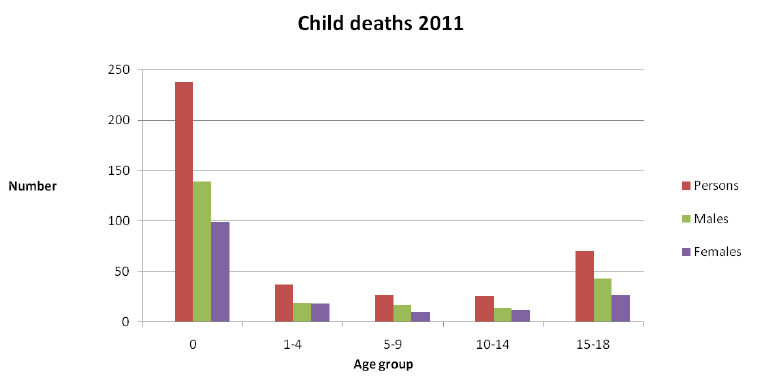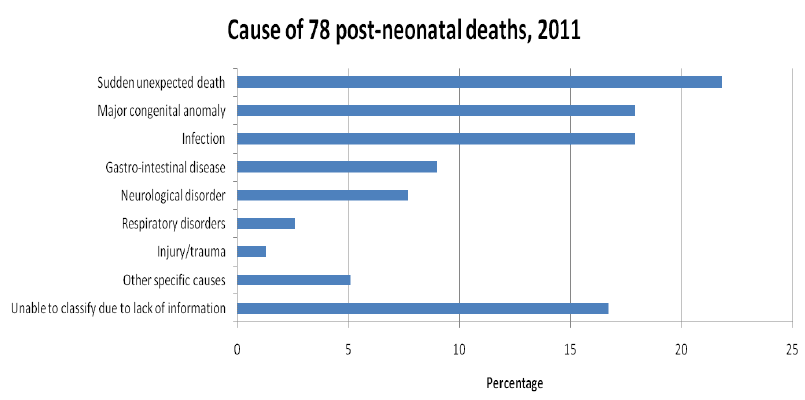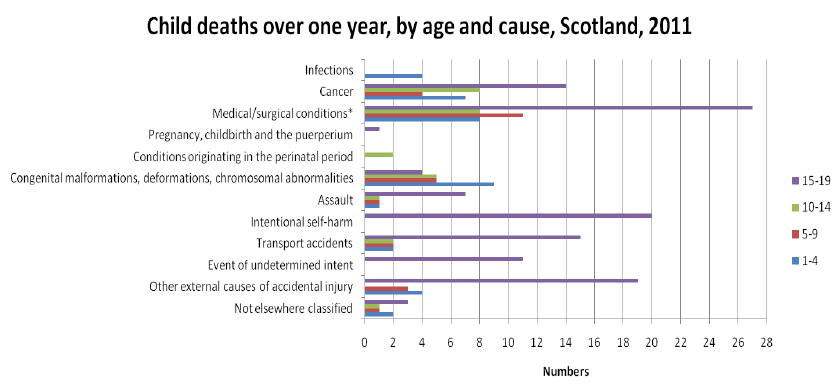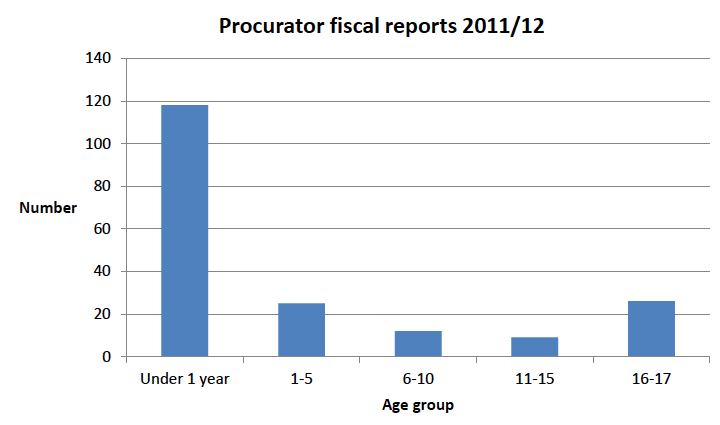Child Death Review Report : Scottish Government Child Death Review Working Group
A report by a Scottish Government short-life working group which explored current practice in Scotland and considered whether Scotland should introduce a national collaborative multi-agency system for reviewing the circumstances surrounding the death of a child.
Appendix 2: Epidemiology of child deaths in Scotland
1. Of 398 child deaths in 2011, the majority (60%) occurred in those aged under one year with most of these occurring within the first four weeks of life.4 The predominant factors associated with singleton neonatal deaths (ie within the first four weeks of life) are congenital anomalies and factors associated with prematurity, including respiratory disorders.9
Figure 1: Child deaths in Scotland 2011, by sex. Source: GROS4

In children aged between 4 weeks and one year, sudden unexpected death is the most frequent cause of death although the number of deaths from sudden unexpected death in infancy (SUDI) has fallen over the past 15 years.
Figure 2: Causes of 78 post-neonatal (occurring after four weeks but before one year of life) deaths, Scotland, 2011. Source: ISD9

2. The second largest group of child deaths by age is the 15-18 year old category. Aside from medical and surgical conditions (which have been combined) the largest causes of death in 2011 in the 15-18 year old age group were due to external factors: "intentional self-harm", followed by "other external causes of accidental death" and "transport accidents" (Figure 3).
Figure 3: Child deaths over one year, by age and cause, Scotland 2011 (note due to data available from GROS deaths in those aged 19 are included in this chart). Source: GROS4

* Includes: D50-89 III. Diseases of the blood and blood-forming organs and certain disorders involving the immune mechanism
E00-90 IV. Endocrine, nutritional and metabolic diseases
G00-H95 VI-VIII. Diseases of the nervous system and the sense organs
I00-99 IX. Diseases of the circulatory system
J00-99 X. Diseases of the respiratory system
K00-93 XI. Diseases of the digestive system
L00-99 XII. Diseases of the skin and subcutaneous tissue
M00-99 XIII. Diseases of the musculoskeletal system and connective tissue
N00-99 XIV. Diseases of the genitourinary system
3. There were nine child homicides in Scotland in 2011/12. The five-year average homicide rate has increased in the last two years, but is still lower than at any other point between 1981 and 2008/09.27
4. All sudden, suspicious, accidental and unexplained deaths must be reported to Procurator Fiscal for investigation.26 There were 190 reports to the Procurator Fiscal during the fiscal year 2011/12 in those aged under 18. This figure is around 51% of deaths in this age group. The majority of reports were for those aged less than one with the next largest category being those aged 16-17. There were 91 recorded Procurator Fiscal investigations completed in the same fiscal year (these may include investigations commenced in previous fiscal years). Very few progress to Fatal Accident Inquiries (FAIs). Over the period 2007 to 2013 there were 19 completed FAIs.
Figure 4: Reports to Procurator Fiscal 2011/12, Scotland, by age group.

Source: ad hoc query to Scottish Fatalities Investigation Unit
5. Differences in the death registration systems used in each nation may have an impact on the comparability of data between nations in the UK. However, National Society for the Prevention of Cruelty to Children analysis found that, in 2011, the rate of deaths due to assault and undetermined intent was highest in Scotland at 5.2 per million, followed by 3.9 per million in Northern Ireland and 3.6 per million in England and Wales. However, in all nations the average rate has decreased since the 1980s. For child suicides in Scotland, the five-year average rate has increased by 77% since 1984, however since 2003 the average rate has been on a downward trend.25
6. Rates of child deaths due to injury have decreased over the past three decades but recent research suggests they may be higher in Scotland compared to England.27
7. There are significant inequalities in deaths in children. There is an association between obesity, smoking and deprivation with stillbirth and infant death,10 and evidence has consistently shown a link between socioeconomic status and child mortality12,28. Deaths in children from injury may have fallen over the thirty years, but this is less so for children from families with lower socioeconomic status.12
Contact
Email: Mary Sloan
There is a problem
Thanks for your feedback